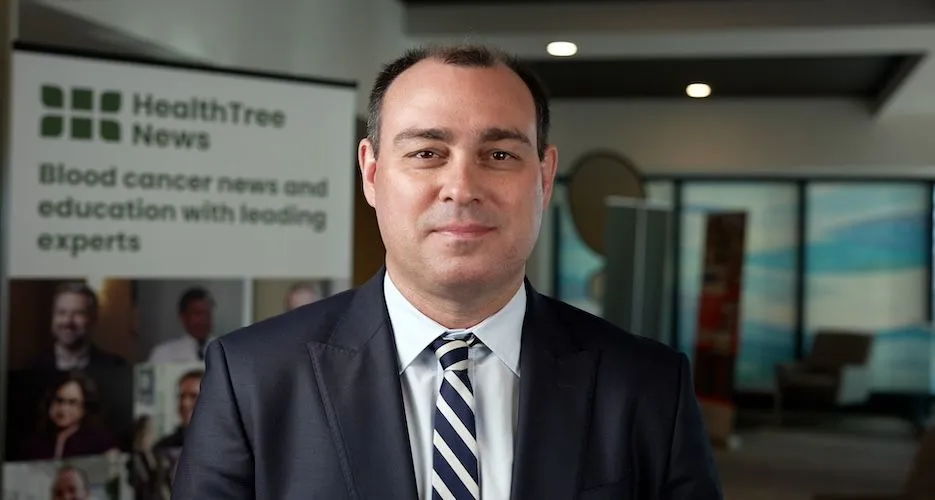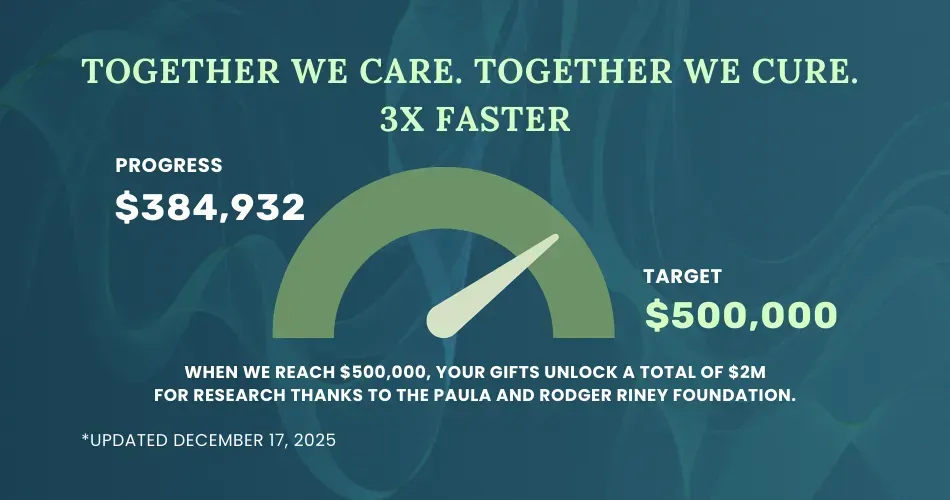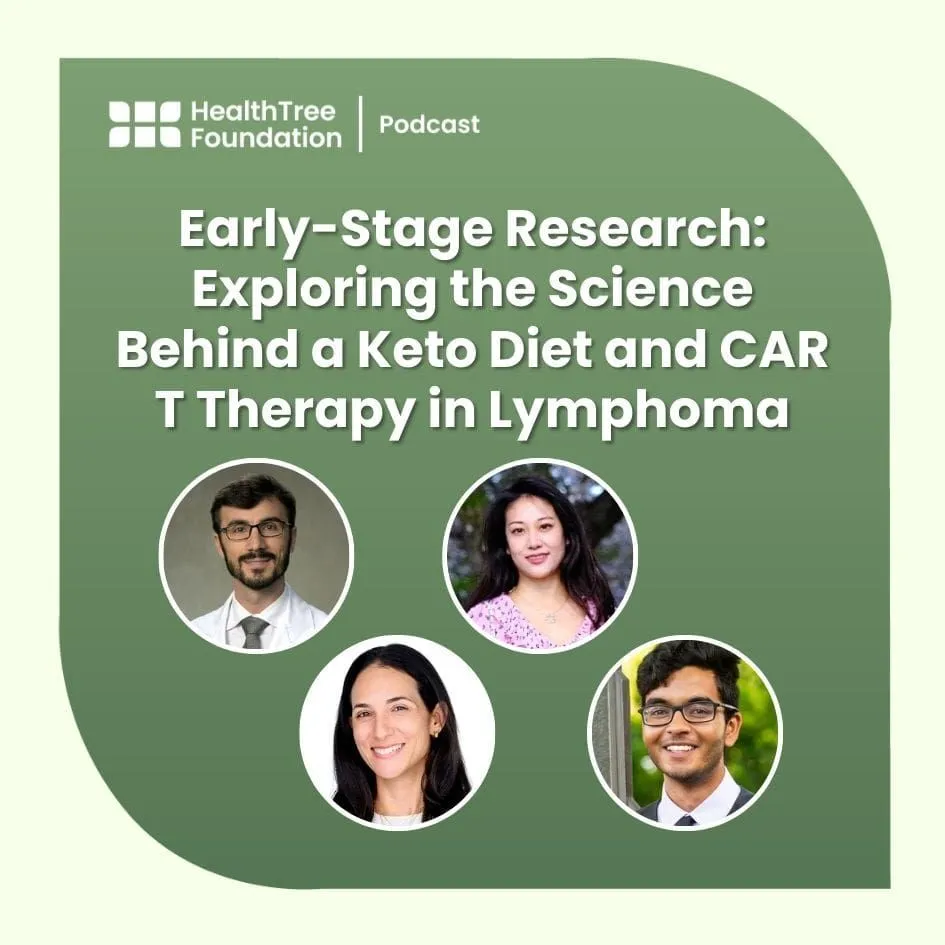PET Biomarkers in Lymphoma

Episode Summary
Defining and tracking progression/remission in DLBCL patients can be subjective and complicated. In this episode, we are joined by Dr. Juan Pablo Alderuccio, a lymphoma specialist at the University of Miami. Dr. Alderuccio recently published his research on PET-based biomarkers in lymphoma patients. His research aims to give patients a more accurate knowledge of their lymphoma prognosis.
Thank you to our episode sponsor, Regeneron
Full Transcript
Kat: Welcome to today’s episode of HealthTree Podcast for DLBCL and Follicular Lymphoma, a show that connects patients with lymphoma researchers. I'm your host, Kat Richardson. We'd like to thank our episode sponsor, Regeneron, for their support of this HealthTree Podcast show. Before we get started, I'd like to make an announcement about an upcoming event that we'll be hosting in April.
On April 3rd, we will have a virtual roundtable discussion with three lymphoma specialists about the basics of follicular lymphoma. You can register for this event by visiting https://healthtree.org/dlbcl/community/events. Now about today's event:
A common challenge with lymphoma is determining the state of the disease and how much the lymphoma has progressed or regressed. Professor Alderuccio has been working with his team to find out how PET-CT biomarkers can change this. We are so pleased to have you here with us today on our show, Doctor. But before we get started, I'll provide a quick introduction for you. Dr. Alderuccio is a clinical investigator who specializes in the study and treatment of patients with lymphoma. His area of primary research is clinical and translational research in lymphoma. He has a strong interest in indolent and aggressive lymphomas, particularly in the implementation of quantitative FDG-PET-CT analysis in the risk stratification and evaluation of novel therapies in lymphoma patients. He is based at the University of Miami in Florida, where he is also an associate professor. Thank you so much for joining us today, doctor.
Juan Alderuccio: Thank you for having me.
Kat: With that, we'll get started with some questions. We'll start with some basics about your research and kind of what it's about. Can you explain to us what a biomarker is?
Juan Alderuccio: Yeah, a biomarker is defined as a variable that objectively measures and is associated with clinical outcomes. Biomarkers are highly relevant in the field of oncology because they can predict outcomes, can be associated with prognosis, and also can predict response to specific therapies. Over the last years, it has been very helpful in monitoring disease progression, something called MRD or minimal residual disease. Biomarkers can broadly be classified into two groups, prognostic biomarkers, which are associated with outcome, independent of the treatment, and predictive biomarkers, which measure the likelihood of response to a certain therapy and can identify which patients will benefit the most from specific treatments.
Kat: Okay, that's very helpful. And what biomarkers are unique to lymphoma?
Juan Alderuccio: In lymphoma, several biomarkers have been proposed over the last few years. Unfortunately, in the field, we don't have predictive biomarkers, except for a specific mutation called EZH2 mutation that is usually more frequently observed in follicular lymphoma. Patients with this specific mutation may benefit from a medication called tazemetostat, which is an ECH2 inhibitor. However, compared to our colleagues from Solid Oncology or some type of leukemias, we don't have any other clinically actionable biomarker or mutation in lymphoma.
Another type of biomarker that we use for prognosis is, for example, the Ki67 in patients with mantle cell lymphoma, which is higher, usually above 30%, and is associated with more aggressive disease curves. In patients with large B cell lymphoma, the presence of translocation in two genes MYC and BCL2 is usually associated with more aggressive disease behavior. However, with more recent therapies, such as CAR T cells seems that they are capable of overcoming at least partially these high-risk features.
Kat: Okay. So you're saying that there aren't a ton of biomarkers that are predictive for the state of the disease in lymphoma.
Juan Alderuccio: Yes, that's correct, but there are a few that we use in practice or we use in practice to change our treatment plan. So to decide if a patient will receive treatment A or treatment B.
Kat: Okay, that makes sense. And then, how are these biomarkers used to track the progression or regression of the disease? What does each biomarker indicate? You kind of went over that, but if you could just tell us what you might see in a biomarker that might tell you how to proceed with treatment.
Juan Alderuccio: Yeah, so the response assessment when a patient starts therapy, we repeat the PET-CT, that is the imaging, to see, we want to see that hopefully the disease will respond and the disease is no longer visible during the course of the treatment and what we call end of treatment. Depending on the regimen that can be the end of treatment. For example, in a patient treated with R-CHOP, which is a frequent front-line regimen for large B cell lymphoma, the end of treatment is after six cycles. And when we repeat the PET-CT, hopefully, all the disease is gone. Over the last years, molecular tests have been developed, specifically ctDNA, which is a blood test where we are able to track the disease and monitor for potential disease recurrence.
So far, this is not a broadly used biomarker, and it's not broadly available, but efforts are being conducted to try to standardize this technique and be available for initial risk assessment, because sometimes when the concentration of ctDNA is higher, higher is the risk of treatment failure. When the patient starts treatment, monitor with that blood test called ctDNA.
Kat: Okay, perfect. I have some kind of feasibility questions to ask now. How often would tests be done for a patient during and following treatment if they were to get this PET-CT scan?
Juan Alderuccio: Yeah, PET-CT is usually done at the time of diagnosis to assess for disease burden. And the PET-CT is very useful in providing the staging. Nowadays, the staging to say that the patient is stage one, two, three, or four is based on PET-CT data. And sometimes in some specific histologies, we also perform a bone marrow biopsy. Nevertheless, over the last years, PET-CT has been demonstrated to be very useful in diseases like large B cell lymphoma and Hodgkin lymphoma to detect bone marrow involvement. So sometimes we don't need to do this test anymore for these two diseases. Then we usually repeat the PET-CT, what we call interim PET-CT, after three to four cycles of treatment to assess the response that has been obtained so far and then at the end of treatment because we want to make sure that the patient responds.
What we use is something called the … criteria that we compare how hot the lesion is in the pectin, how bright the lesion is compared to the vessels in the heart, around the heart, what we call mediastinal blood pool, and with the liver. If that score is between one to three, we say that the patient achieved a complete response.
Kat: Okay, perfect. So is that different than the standard right now or is that the standard?
Juan Alderuccio: No, that's the standard of care. Hopefully in the near future, we will be able to also incorporate ctDNA. Probably not for the staging, but yes, for a more granular assessment of response, as the ctDNA can be measured at the molecular level that PET-CT or imagines are not able to obtain.
Kat: Okay, perfect. As far as biomarker tests go, are some more accessible due to location and cost versus others, or do all patients have the same accessibility to these tests?
Juan Alderuccio: So usually PET-CT is broadly available. Usually, it's at a radiology center. For several years has been the standard of care. At least for using the response assessment that we use called Lugano criteria, which was published in 2014. Since 2014, they have recommended the use of PET-CT. This is supported by the NCCN guidelines. So I would say that PET-CT is a technique that is probably available at several locations and doesn't require significant technology in order to analyze this type of image.
Kat: Okay, perfect. What are some of the challenges with the biomarker efficacy? Are they always accurate? Are they less accurate?
Juan Alderuccio: Yeah, so biomarkers, myself and the group here in Miami, over the last years, we have been working on some specific PET-CT biomarkers, specifically one called metabolic tumor volume. Other groups from the United Kingdom and other centers in Europe have been doing the same. And the challenge is the the standardization of the measurement, and then the validity. When you develop a new biomarker, you need to prove in different data sets, meaning in different patient populations, that the biomarker is useful. Metabolic tumor volume across several studies has proved that. However, there are some variabilities in how to calculate this biomarker. That's one of the main reasons why it has not been introduced to us as a standard of care in clinical practice.
Kat: Okay, so currently, the standard of care is these patients are still getting PET scans, but it's hard to quantify kind of and get a consistent diagnosis. Okay.
Juan Alderuccio: Yes, correct. So currently, if a patient has a new diagnosis of large B-cell lymphoma or follicular lymphoma, the patient has a PET-CT to determine the stage. But that's most of the information that is obtained from PET-CT nowadays. Also, the PET-CT helps the treating physician to decide what area will need a biopsy if the diagnosis remains unclear. For example, the patient has a low-grade lymphoma, such as follicular lymphoma, and there are concerns about transformation to a more aggressive type of lymphoma. Usually, we select areas with the highest SUV, that is the area that takes more radiotracer, the substance that is provided for the PET-CT. We like to do a biopsy of that area to make sure that the disease has not transformed into a large B cell lymphoma. So that's are the two main reasons why we do PET-CTs in routine practice.
Kat: Makes sense. So kind of the goal would be to have the ability to quantify PET-CTs for these patients and there wouldn't be discrepancies if I went to one physician versus another, they'd see the same number versus kind of interpreting it.
Juan Alderuccio: So currently, if a patient goes to see a different physician for a second opinion to another physician, the staging should not change. That is pretty standard and has been used since the 70s. So there should not be a significant change. However, different PET-CT biomarkers, such as metabolic tumor volume, may differ if two centers have the capabilities to measure because it depends on how they do it, and that's why we don't have an agreement yet.
Kat: Can you give us a bit of history on PET-CT scans, how they work, what indications are needed to have a test like that, and patient safety with those tests?
Juan Alderuccio: Yeah, so PET-CT has been the standard imaging approach for patients with lymphoma, especially those with follicular lymphoma, large B cell lymphoma, and Hodgkin lymphoma. There is still some discussion about the role of PET-CT in patients with small lymphocytic leukemia and chronic lymphocytic leukemia, and also in patients with marginal cell lymphoma and Waldenstrom for CT scans because of concerns of low uptake of the radiotracer. But across most lymphomas, PET-CT is a standard of care for initial disease staging and to assess tumor response. The PET-CT is a nuclear medicine technique that uses a radioactive
material called a radiotracer. In this case, it is FDG, which is radioactive glucose/radioactive sugar, that is injected into the patient. The reason why we use this is because the lymphoma produces a higher uptake compared to normal tissues and allows us to identify the abnormal area. This could be within the lymph nodes, called nodal disease, or outside the lymph nodes, called extranodal disease, for example, in the bone marrow, the bone, the lung, the liver, or any other organ, we would call this extranodal disease.
Regarding safety, the main safety concern is the amount of PET-CTs and the amount of radiation that the patient receives. Many lymphomas are considered curable diseases. So we need to be careful when the patient finishes therapy if, the patient achieves a complete response. In that case, for surveillance, we usually don't use PET-CT because the dose of radiation can be higher than CT scans. Sometimes we don't even do CT scans and we just monitor the patient by talking to the patient, making sure that they haven’t developed new symptoms, and with a physical exam and some basic blood work. This is to decrease the risk of secondary malignancies that can be associated with this type of radiation.
Kat: Okay, perfect. So just to clarify for our patients, typically, you hear PET and then CT as two separate things. When you say PET-CT, is that combined?
Juan Alderuccio: So PET is not the same. The study says PET-CT, which includes a CT portion. However, this is done without IV iodine contrast which is usually done with a CT scan. The contrast that we use with PET is the FDG which is the radioactive glucose. The PET-CT is a fusion study where you fuse images from nuclear medicine, but the CT portion is done without iodine contrast. The contrast is for the PET part of the study.
Kat: Okay, perfect. Are there any reasons a patient couldn't get a PET-CT scan, like their size or ability to, I think you said that you inject the contrast, but do they need to be able to drink anything for this kind of scan?
Juan Alderuccio: No, the patient doesn't need to drink. Sometimes when the patient has diabetes and the blood glucose is very high, we need to reschedule the study until the patient is able to decrease the glucose levels in the blood because of some abnormalities that can occur in the uptake of the PET-CT and affect image acquisition. There are overall no significant contraindications. A contraindication for patients for CT with intravenous iodine is when the patient has a chronic kidney disease. That can produce some abnormalities in renal function. This is not a common issue and patients with chronic kidney disease can undergo PET-CTs without problems.
Kat: Are there any substitute tests if they couldn't do a PET-CT scan?
Juan Alderuccio: So if the patient for some reason cannot have a PET-CT, we still do a CT scan with IV contrast.
Kat: Okay, do you ever find that patients are very hesitant about the radioactive portion of this and don't want to get a CT or a PET scan?
Juan Alderuccio: No, usually no. If the patient has a concern, we discuss and we explain that the PET-CT provides more meaningful information for the staging and also for the response, more granular information compared to the CT scans. Usually, that addresses most of the patient's concerns.
Kat: Thank you for that. Now I think we'll move on to some study-specific questions.
So will you just give us a quick overview of your quantitative PET biomarker study or study proposal that you have done with your team?
Juan Alderuccio: Yes, so we have been measuring a PET-CT biomarker called metabolic tumor volume or MTB, which is a quantitative biomarker which is extracted from the routine PET-CT scan. What we do is we use a special software, there are multiple software in the market, from free, to some that require payment. We are able to extract this data and the metabolic tumor volume. What it does is reflect what we call the glycolytic phenotype, so how much glucose of this radiologic, radiotracer that we administrate through the vein, the lymphoma takes, and the overall tumor burden. What is important is the higher the volume that we obtain, which usually is in milliliters. The higher this volume is, the higher the patient's risk is. This has been shown in patients with untreated follicular lymphoma, in untreated diffuse large visceral lymphoma, and in patients with relapsed refractory diffuse large B cell lymphoma.
Those with higher values of metabolic tumor volume are usually those patients with worse prognosis. Then we calculate these volumes in the different areas of uptake, and then the volumes of the individual lesions are added to determine what we call the total body metabolic tumor volume.
What we did in a recent publication in clinical cancer research is we centrally reviewed PET-CT scans of patients with relapsed or refractory diffuse large B cell lymphoma who were enrolled in a clinical trial called LOTIS-2. This was an international multi-center clinical trial that tested a medication called loncastuximab tesirine. This study led to the FDA approval of this agent. We analyzed here at the University of Miami, the screening PET-CTs of these patients before therapy. What we found is that a cutoff point of 96 milliliters of metabolic tumor volume was associated with the highest predictive performance in different models to predict failure to achieve a complete response and shorter progression-free survival and overall survival treated with this agent. So in other words, patients with a metabolic tumor volume above 96 demonstrated lower chances to respond to loncastuximab compared to patients with a lower tumor volume.
Kat: Okay. So how would you define, in simple terms, total metabolic tumor volume, if you were to describe that to a patient?
Juan Alderuccio: So it is the volume of disease, which is metabolically active. Because in metabolic tumor volume, we measure two things: disease burden and also how much of the tracer concentrates each lesion. It's not like in the staging that we only assess where the disease is located. Here, we also measure the activity inside the lymphoma area.
Kat: Thank you. Can you describe what these scans look like and what they mean to you as a physician? Are you able to kind of give us a definition or description of what you see and kind of how you proceed with treatment when you see these scans?
Juan Alderuccio: We don't use metabolic tumor volume to define treatment outside of a clinical trial. But we know that patients with advanced-stage disease, stages three and four, should receive a full course of treatment. For example, in large B cell lymphoma, the patient requires six cycles of treatment.
However, a patient with localized disease, what we call a stage one disease, can receive an abbreviated course of chemotherapy that can be between three to four cycles depending on the program that the treating physician wants to follow.
Nevertheless, here at the University of Miami, we are going to start a clinical trial. What we will do is we will decide treatment based on metabolic tumor volume before treatment initiation. Currently, if the patient has a metabolic tumor volume of 10 or a metabolic tumor volume is 600, the patient receives the same treatment because both patients have stage four. And the standard of care is to provide the same regimen. However, we think that treatment can be personalized and adjusted based on metabolic tumor volume. This study will start in the near future here at Miami in patients with advanced-stage Hodgkin lymphoma treated with BV-AVD.
Kat: Okay, so that's interesting that even though it seems like a large difference in total metabolic tumor volume, they would still be treated the same because if it's stage four, it's just stage four.
Juan Alderuccio: Yes, so the standard of care for patients with stage 3 or 4 Hodgkin lymphoma in 2024 is to receive BV-AVD, six cycles, so 12 treatments of this program. However, what we want to test is patients with advanced-stage disease. We will divide patients into high metabolic tumor volume and low metabolic tumor volume. Patients with high-risk metabolic tumor volume will receive the standard treatment program of six cycles. However, patients with low-risk metabolic tumor volume will receive a shorter treatment program. We will also monitor the course of the disease and the response at a molecular level with ctDNA in this clinical trial. However, this type of modification needs to be done in the context of a clinical trial. It should not be done outside these types of interventions.
Kat: Okay, from what I understand, sometimes with follicular lymphoma, they might not treat it right away. What would a PET-CT show if you were to not treat follicular lymphoma right away?
Juan Alderuccio: Follicular lymphoma is classified into subtypes. So patients with localized disease, for example, only a few lymph nodes in the neck or in the groin, that is stage one follicular lymphoma. In that case, we treat with radiation therapy because, for patients with localized follicular lymphoma, radiation therapy has the potential to achieve long-term remission.
However, patients with stage three or four, what we call advanced stage disease, we classify into groups: Patients with low disease burden and patients with a high tumor disease burden. We use the GELF criteria to determine if the patient has low-volume disease or high-volume disease.
Patients with advanced-stage disease and low-volume disease, for example, patients that are asymptomatic, that don't have night sweats, weight loss, fever, don't have pain, don't have a large spleen, their white blood cells are normal, the hemoglobin is normal, platelets are normal, there are no effusions, and there is no bulky disease, for those patients, if they don't present any of those characteristics, the patient can be observed. That has been shown to not change the outcome. However, those patients with high disease burden, that have any of one of the points of the GELF criteria, are the patients we usually select for therapy.
Kat: Okay, so when you're deciding about therapy or not, you also consider their symptoms, along with the actual biomarkers and tests.
Juan Alderuccio: Absolutely, we consider what we see in the scans, but probably most important is how the patient feels and also what we find on physical exam.
Kat: Perfect, thank you. And then, with this method of testing that we've been talking about, how can you quantify the status of lymphoma?
Juan Alderuccio: So the stage itself doesn't change; what changes is the prognosis. What we are trying to do is work with different pharmaceutical companies in order to retrieve PET-CTs of patients in clinical trials and try to develop predictive biomarkers. So we are trying to develop specific cut points of metabolic tumor volume that will determine if the patient will respond or not to a specific therapy. And we think that that's very meaningful because if the patient has relapsed large B cell lymphoma or after two or three lines of therapy and the patient is considering treatment A or treatment B, and we know that with treatment A the probability to respond is a metabolic tumor volume of 50 milliliters, and the patient has a metabolic tumor volume of 80 milliliters, I will not choose treatment A because of this data. And most likely the patient should go to another type of therapy. So the goal of these biomarkers is to inform the treating physician about the probabilities of response to specific therapies. And that's what it's called predictive biomarkers.
Kat: Okay, perfect. How can discrepancies be avoided with this method of testing?
Juan Alderuccio: So we are trying to obtain an agreement between nuclear medicine physicians and lymphoma physicians to see what is the best threshold to calculate metabolic tumor volume and also to validate a specific cut point. Once we achieve that agreement, then we can start to use this type of technology to make decisions in the clinic. But until that happens outside of a clinical trial, we are not able to do this, unfortunately.
Kat: Have there been any results from your research? I know that it's kind of more of a proposal right now but are there any definite results at the moment?
Juan Alderuccio: So the results, yeah, we recently submitted an abstract to the Society of Nuclear Medicine, specifically looking at metabolic tumor volume in patients with advanced stage Hodgkin Lymphoma treated with BV-AVD. Metabolic tumor volume helped to identify what patients will have more toxicity to the therapy and also what patients will benefit the most from this therapy and what patients may not. So we were able to identify specific cut points, which we are going to test in this upcoming clinical trial.
Kat: What kind of clinical trials can you picture will be done based on your observations from you and your team? Will they be nationwide?Will they be international? How big of a population do you expect, and kinda how do you see them going?
Juan Alderuccio: So at this point, our first step is to start this study in Hodgkin lymphoma. We think we will enroll approximately 40 patients with this disease at Sylvester Comprehensive Cancer Center and across all our satellites. That will be the first step. And then based on the results, we may consider expanding to other centers. But the first step, I think, is to start with a single-center study.
Kat: Okay, that makes sense. And do you have a timeline for that? Or is that just the hope of coming soon?
Juan Alderuccio: No, we are expecting to open this type of study in the third quarter of 2024.
Kat: How can you see the results of these potential studies changing the future of lymphoma treatment?
Juan Alderuccio: I think using metabolic tumor volume and ctDNA may help to better risk stratify patients and to identify what patients are the highest risk patients that will be at risk for treatment failure and providing different therapies to improve outcomes.
Also to improve toxicity in patients with lower disease burden that have higher chances of response compared to other groups. This will help to de-escalate treatment in patients with low metabolic tumor volume and low concentration of ctDNA. And that will be very meaningful because we will be able to decrease short-term and long-term complications from the treatment.
Kat: Realistically, if you went through the clinical trials and moved forward with everything and got approval, how long from now could you imagine this becoming a standard of care if it were to pass everything?
Juan Alderuccio: I think it will probably take at least three years.
Kat: Okay, I guess that's not too long in terms of clinical trials.
Juan Alderuccio: Yeah, I have been very optimistic, but we have a big center in South Florida, so we think that we can enroll that amount of patients in approximately two years, two years and a half. And also, we are also trying to understand what is the role of ctDNA in Hodgkin lymphoma, which is more unclear compared to B cell lymphomas, especially large B cell lymphoma, and follicular lymphoma.
So we think that will provide a better understanding of these two features of an imaging biomarker and a circulatory biomarker like ctDNA.
Kat: I imagine with a study like this where we're just kind of looking more at testing, you don't have the barriers of side effects and all that with patients because safety really isn't a huge concern here.
Juan Alderuccio: Yes, absolutely, especially in a highly curable disease such as Hodgkin lymphoma
Kat: What are some challenges that you expect while trying to get this method of testing to become the standard of care? What can you see being barriers for you?
Juan Alderuccio: So the barrier is that we will need external validation. We will need to expand to a multi-center type of effort. That takes time. That's the main challenge that I see, external validation of our results.
Kat: I see. Now I have a few questions that were submitted by patients and or caregivers. They will probably be somewhat repetitive, but these are pre-submitted. And just maybe for clarification, we can go over them again. One of the questions is, would these biomarkers be only used for patients after treatment? When are the scans done and how often?
Juan Alderuccio: No, the goal of these biomarkers is to do pre-treatment, before treatment. Eventually and hopefully, through a clinical trial and then as a standard of care, we can decrease the amount of therapy. So this is going to be pre-treatment. And what was the second part of the question?
Kat: When would the scans be done and how often?
Juan Alderuccio: We make the decision based on the initial PET-CT.
Kat: So if you had a research study done on this, would every patient just get one scan before treatment or they have any follow-up scans after treatment?
Juan Alderuccio: They will have regular follow-up scans of the interim and the end of treatment. However, the decision about the length of therapy is taken based on the initial PET-CT.
Kat: Okay, another question was, as a patient, how can I participate in this research? Is it a possibility to participate at all?
Juan Alderuccio: So patients are able to participate in this type of study based on the diagnosis and also some eligibility requirements and also depending on the location where the patient lives. So I strongly recommend that patients discuss the possibility of clinical trials with their hematologist or oncologist to see how they can participate in these types of efforts.
Kat: And I know you mentioned that the qualification with your study that you're hoping to do at the end of this year, which would just be in Miami from what it sounds like. What would be the biggest inclusion and exclusion criteria with that?
Juan Alderuccio: It's going to be in South Florida. The biggest inclusion criteria will be the advanced stage Hodgkin lymphoma. So this patient needs to be present in stage three or four. And the main exclusion criteria are patients with severe neuropathy.
Kat: Okay. And you said the reason that you're doing advanced stage Hodgkin is because those have less, there's less knowledge with that, correct?
Juan Alderuccio: There’s less knowledge, it's a high-risk population, and nowadays, we treat exactly the same, regardless of whether the patient has high disease burden or low disease burden. And we think that in those patients with low disease burden, we can de-escalate the treatment. And hopefully, we will show that it's safe to do that.
Kat: Gotcha. And then one more question from a patient. Will PET-CT based biomarkers increase my chance of longer survival or only better predict my prognosis?
Juan Alderuccio: So I think we need to be cautious about the interpretation of these biomarkers outside of a clinical trial. The lymphoma field is having significant advances year by year. We have better drugs, we have better outcomes. So a biomarker that was prognostic five years ago, ten years ago, may no longer be in 2024.
I think it's very important that the patients discuss these concerns with their physicians, because for example, in large B cell lymphoma, we have CAR T cells now, we have bispecifics, and several other clinical trials. So I think that the patients should always discuss how to interpret this data with the treating physician because the prognosis of lymphoma is significantly improving year by year. So something that may be associated with outcomes in the past, may no longer be true in 2024.
Kat: I see. I appreciate that. And that's all the questions that we have for today. Thank you so much, Dr. Alderrucio for joining us. We're so grateful for your generosity with your time and willingness to share your incredible expertise with us. We're excited for what's to come for you this year. We would love to have you on the show again in the future to share some updates on your exciting clinical trial. We wish you the best in your clinical practice and your research endeavors. Thank you again for your time today, doctor.
Juan Alderuccio: Thank you.
Kat: Thank you for listening to Health Tree Podcasts for DLBCL and Follicular Lymphoma. Join us next time to learn more about what's happening in lymphoma research and what it means for you. Once again, thank you to Dr. Alderuccio and our sponsor Regeneron for making this event possible. Have a great day.
Trending Articles
Have Any Questions?
Thank you for your interest in the event. If you have any questions, we would love to help!
Feel free to give us a call or send us a message below.

Get In Touch With Us
1-800-709-1113
Support@healthtree.org
More Podcast Episodes
Get the Latest Large B Cell Lymphoma Updates, Delivered to You.
By subscribing to the HealthTree newsletter, you'll receive the latest research, treatment updates, and expert insights to help you navigate your health.
Together we care.
Together we cure.
3x Faster.







